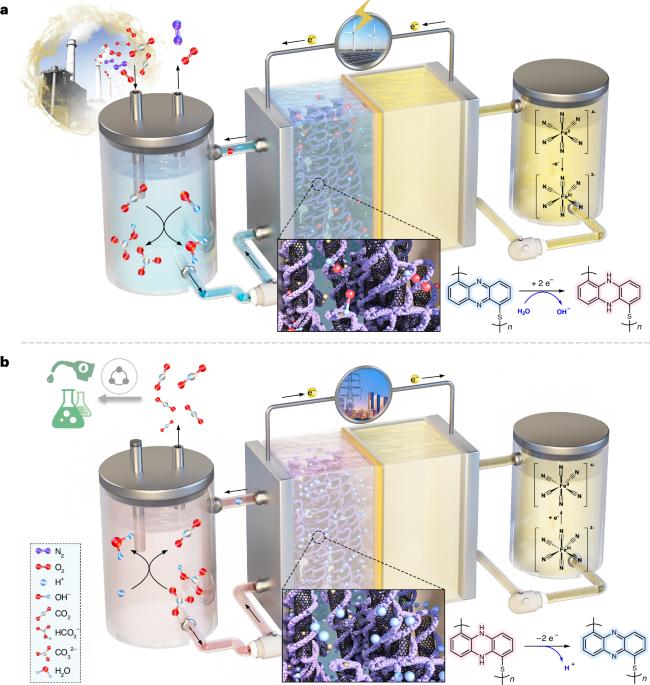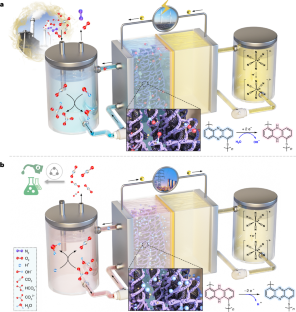Direct air capture of CO2 in an electrochemical hybrid flow cell with a spatially isolated phenazine electrode
IF 60.1
1区 材料科学
Q1 ENERGY & FUELS
引用次数: 0
Abstract
CO2 capture based on a pH swing driven electrically through the reversible proton-coupled electron transfer of organic molecules could be powered entirely by clean electricity. A major technical challenge is the reversible chemical oxidation of the reduced organics by atmospheric O2, which can lower energy efficiency and capture capacity. Here we report the development of a hybrid phenazine flow cell system that uses a pH-swing direct air capture (DAC) process, utilizing redox-active cyclic poly(phenazine sulfide) fabricated solid electrodes. The system maintains a separation between the air and the O2-sensitive reduced phenazine, enabling stable and effective CO2 capture from gas mixtures containing O2. This flow cell demonstrated substantial oxygen compatibility, exhibiting a coulombic efficiency of 99% and requiring only 73 kJ mol−1 CO2 for simulated flue gas and 104 kJ mol−1 CO2 for DAC. The strategy of isolating vulnerable species offers an efficient pathway for DAC and may be broadly applicable to avoiding undesirable side reactions in other electrochemical devices. Electrochemical CO2 capture is hindered by the oxidation of redox-active organic molecules by O2, affecting energy efficiency and capacity. Here the authors develop a flow cell in which the O2-sensitive components are isolated from O2, achieving 99% coulombic efficiency with low energy requirements.


用空间隔离的非那嗪电极在电化学混合流动电池中直接空气捕获CO2
通过可逆质子耦合的有机分子电子转移,基于pH值波动的二氧化碳捕获可以完全由清洁电力驱动。一个主要的技术挑战是被还原的有机物被大气中的O2可逆化学氧化,这会降低能源效率和捕获能力。在这里,我们报告了一种混合非那嗪流动电池系统的发展,该系统使用ph -摆动直接空气捕获(DAC)工艺,利用氧化还原活性环聚(非那嗪硫化物)制造的固体电极。该系统保持空气和对O2敏感的还原苯那嗪之间的分离,从而能够从含有O2的气体混合物中稳定有效地捕获二氧化碳。该液流电池表现出良好的氧相容性,库伦效率为99%,模拟烟气仅需73 kJ mol - 1 CO2, DAC仅需104 kJ mol - 1 CO2。分离易感物质的策略为DAC提供了一条有效的途径,并可广泛应用于避免其他电化学器件中的不良副反应。
本文章由计算机程序翻译,如有差异,请以英文原文为准。
求助全文
约1分钟内获得全文
求助全文
来源期刊

Nature Energy
Energy-Energy Engineering and Power Technology
CiteScore
75.10
自引率
1.10%
发文量
193
期刊介绍:
Nature Energy is a monthly, online-only journal committed to showcasing the most impactful research on energy, covering everything from its generation and distribution to the societal implications of energy technologies and policies.
With a focus on exploring all facets of the ongoing energy discourse, Nature Energy delves into topics such as energy generation, storage, distribution, management, and the societal impacts of energy technologies and policies. Emphasizing studies that push the boundaries of knowledge and contribute to the development of next-generation solutions, the journal serves as a platform for the exchange of ideas among stakeholders at the forefront of the energy sector.
Maintaining the hallmark standards of the Nature brand, Nature Energy boasts a dedicated team of professional editors, a rigorous peer-review process, meticulous copy-editing and production, rapid publication times, and editorial independence.
In addition to original research articles, Nature Energy also publishes a range of content types, including Comments, Perspectives, Reviews, News & Views, Features, and Correspondence, covering a diverse array of disciplines relevant to the field of energy.
 求助内容:
求助内容: 应助结果提醒方式:
应助结果提醒方式:


